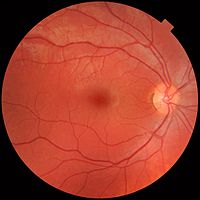
Photo from wikipedia
Aim To explore and evaluate an appropriate deep learning system (DLS) for the detection of 12 major fundus diseases using colour fundus photography. Methods Diagnostic performance of a DLS was… Click to show full abstract
Aim To explore and evaluate an appropriate deep learning system (DLS) for the detection of 12 major fundus diseases using colour fundus photography. Methods Diagnostic performance of a DLS was tested on the detection of normal fundus and 12 major fundus diseases including referable diabetic retinopathy, pathologic myopic retinal degeneration, retinal vein occlusion, retinitis pigmentosa, retinal detachment, wet and dry age-related macular degeneration, epiretinal membrane, macula hole, possible glaucomatous optic neuropathy, papilledema and optic nerve atrophy. The DLS was developed with 56 738 images and tested with 8176 images from one internal test set and two external test sets. The comparison with human doctors was also conducted. Results The area under the receiver operating characteristic curves of the DLS on the internal test set and the two external test sets were 0.950 (95% CI 0.942 to 0.957) to 0.996 (95% CI 0.994 to 0.998), 0.931 (95% CI 0.923 to 0.939) to 1.000 (95% CI 0.999 to 1.000) and 0.934 (95% CI 0.929 to 0.938) to 1.000 (95% CI 0.999 to 1.000), with sensitivities of 80.4% (95% CI 79.1% to 81.6%) to 97.3% (95% CI 96.7% to 97.8%), 64.6% (95% CI 63.0% to 66.1%) to 100% (95% CI 100% to 100%) and 68.0% (95% CI 67.1% to 68.9%) to 100% (95% CI 100% to 100%), respectively, and specificities of 89.7% (95% CI 88.8% to 90.7%) to 98.1% (95%CI 97.7% to 98.6%), 78.7% (95% CI 77.4% to 80.0%) to 99.6% (95% CI 99.4% to 99.8%) and 88.1% (95% CI 87.4% to 88.7%) to 98.7% (95% CI 98.5% to 99.0%), respectively. When compared with human doctors, the DLS obtained a higher diagnostic sensitivity but lower specificity. Conclusion The proposed DLS is effective in diagnosing normal fundus and 12 major fundus diseases, and thus has much potential for fundus diseases screening in the real world.
Journal Title: British Journal of Ophthalmology
Year Published: 2021
Link to full text (if available)
Share on Social Media: Sign Up to like & get
recommendations!